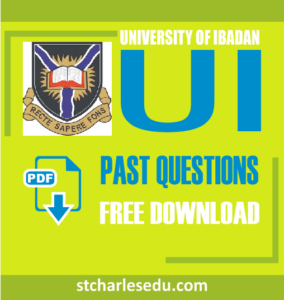Are you in the Faculty of Medicine, eligible for University of Ibadan Admission Screening Exercise, Also know as UI POST UTME.
If yes, you need the UI Post UTME past questions for Medicine and Surgery, to enhance ur preparatory skill in readiness to the exam.
we at stcharlesedu.com has compiled all Unibadan UI Post-UTME past questions for all course in the faculty of Medicine 2019 Edition
This past questions will give you an over-view and nature of the exams.
Past questions will not only help you know the likely questions but you will understand the nature of the examination.
Our research has confirm that candidate who uses UI Faculty of Medicine Past-Questions and Answer specifically to prepare for the Admission Screening Exam into various department in the faculty is 10x times better than those who do not.
Read Also: Download University of Ibadan Post-JAMB Past Questions for Medicine, Engineering, Law,

Table of Contents
UI Post-UTME Subjects for Medicine Combination.
What are the Subjects Written in UI Post UTME for Medicine.
The subjects you will write in University of Ibadan, Oyo State Post Utme is same subjects you wrote in Jamb.
Download UI Post UTME Past Questions for Faculty of Medicine free Sample
UNIVERSITY OF IBADAN, IBADAN.
POST-UTME PRACTICE QUESTIONS & ANSWERS
BIOLOGY
1. ____________ is an end product of digestion of fat.
(A) Glucose
(B) Fatty acid
(C) Amino acid
(D) Fructose
(E) Galactose
2. Asexual reproduction in Hydra sp. is commonly by ____
(A) Binary fission
b. Fragmentation
c. Budding
d. Separation
(E) Regeneration
3. Benedict’s solution is used to test for ___
(A) Carbohydrate
(B) Lipid
(C) Protein
(D) Vitamins
(E) Minerals
4. Pepsin is an enzyme that digests ___
(A). Starch
(B). Sugar
(C). Lipid
(D). Fat
(E). Protein
5. The breakdown of large organic molecules into smaller simpler soluble molecules is called ––
(A) Excretion
(B) Digestion
(C) Absorption
(D) Reproduction
(E) Ingestion
6. The enzyme that curdles milk is_____________
(A). Pepsin
(B). Ptyalin
(C). Renin
(D). Amylase
(E). Trypsin
7. Which is the enzyme that begins digestion of starch in the mouth?
(A) Ptyalin
(B) Maltase
(C) Amylase
(D) Sucrase
(E) Lactase
8. A group of interacting populations in a particular habitat can be described as ___
(A) biome
(B) biosphere
(C) community
(D) population ecosystem
(E) environment.
9. A habitat can be defined as ___
(A) a group of animals and plants living within a common boundary.
(B) a place in which plants and animals live.
(C) a community living together in the same place.
(D) different areas, with a common animal and plant population.
(E) None of the above.
10. A symbiotic relationship in which one organism is completely dependent on another organism is called ____
(A) Parasitism
(B) Commensalisms
(C) Mutualism
(D) Saprophytism
(E) Competition
11. An association between two organisms where both members benefit is known as ___
(A) symbiosis.
(B) commensalism.
(C) ammensalism.
(D) mutualism.
(E) saprophytism.
12. An instrument used in measuring the speed of wind is
(A) a barometer (B) a wind gauge (C) a wind vane (D) an anemometer (E) a hydrometer.
13. At times hyenas feed on remains of animals killed by other animals. At other times, hyenas
themselves kill animals for food. Therefore hyenas may best be described as ––
(A) scavengers and herbivores
(B) scavengers and parasites
(C) scavengers and predators
(D) herbivores and predators
(E). herbivores and parasites
14. Autecology is defined as the study of interrelationship of
(A) many species of organisms and their environment
(B) same species of organisms and their environment.
(C) organisms in the atmosphere.
D) organisms under the earth’s surface.
(E)None of the above.
15. Autotrophs are also described as ––
(A) Consumers
(B) Decomposers
(C) Carnivores
(D) Producers
(E) Herbivores
16. If three 30cm lengths of glass tubing are tightly packed with clay, sand and loamy soils respectively and then stood in a beaker of water for one week the level of water will be
(A) Lowest in the tube with clay
(B) The same in all the tubes
(C) Lowest in the tube with loamy soil
(D) Highest in the tube with sandy soil
(E) Lowest in the tube with sandy soil
17. In a community bacteria and fungi are referred to as ––
(A) producers
(B) consumers
(C) scavengers
(D) tertiary consumers
(E) decomposers
How to Buy UI Past Questions for Faculty of Medicine and Surgery.
To get the complete copy of the Past-Questions, call/whatsapp me on 08051311885.